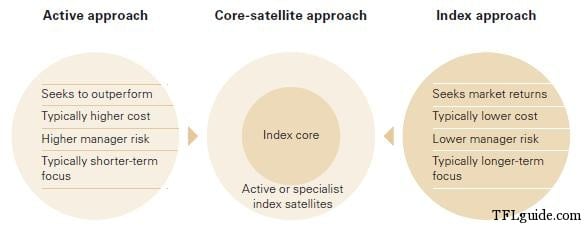Core & Satellite is a very old & proven investment approach. Portfolio construction is a part of the overall investment planning process, that is essential to generate and accumulate wealth in the long-term. Almost everyone has some kind an investment portfolio consisting of assets. For instance, a person having a fixed deposit of, say, Rs 1 lakh and post office savings of Rs 75,000 can also be called portfolio.

You must have read or heard that an investor should have a diversified portfolio. So there are two important terms Diversified & Portfolio.
Diversification – it is dividing your money in different assets or investments. Why? “Don’t keep your eggs in one basket” because if it falls all eggs will be broken. So one should invest his money in different assets like equity, debt, real estate & gold – it should also be further divided on investment level like 5-6 equity funds, 2-3 debt products.
Portfolio – it is a combination of all your investment for a particular goal or all goals or just for wealth creation.
The systematic method of portfolio making involves several factors that come in steps. These include identifying investment goals, assessing one’s risk appetite, deciding on asset allocation as per goals, determining a time horizon, and diversification of asset classes to minimise risk and weather market volatility. The ultimate goal of systematic portfolio making is to maximise returns and minimise risks.
Read – 3 Principles & 3 Practices to generate superior returns
Core & Satellite Portfolio
A significant way to make a systematic or smart portfolio is to divide the assets into core and satellite segments. Core assets, as the name suggests, are an indispensable part of a portfolio without which one cannot realise his/her investment goals. Asset allocation in core assets is planned keeping in view the long-term goals of an investor and to generate higher returns with low risk. Core assets are the foundation of a portfolio and require passive management, which means occasional and not frequent readjustment is required in response to the market dynamics.
The mix of core assets varies according to individual’s goals, risk appetite, time horizon, disposable income, age, among others. For instance, for an investor with a long-term horizon and a high risk appetite, giving a higher weightage to equity in his/her portfolio would better serve the investment goals as a high-risk instrument like equity generates returns in the long term and not in the short term. Similarly, an investor with low risk appetite and short time horizon should allocate more in debt instruments than equities.
Satellite assets, on the other hand, require more active management or rebalancing than core assets. One should not invest more than 15-20% of his investments in satellite assets. Once you allocate amount that is sufficient to achieve your goals – you can think about increasing satellite assets.
Now the question is which should be core assets & which should be satellite assets.
Types of Core & Satellite Portfolios
There are many types of core & satellite portfolios – depending on risk profile & for particular goal that portfolio is constructed.
For risk-averse investor: He can build a core portfolio with most of debt instruments & rest with equities. This will preserve his capital & also help him cross inflation mark. Eg. 80% in debt & 20% in equity.
For Passive Investor: Such investors prefer passive investments like ETF/Index funds (check DSP Black Rock Nifty Index Fund & how its different) over active investments life diversified equity mutual funds. So they can have 60-70% in passive investments & rest in active investments. Internationally this is the most common meaning of Core & Satellite. Check its benefits.

Stability with some additional kick: If we talk about equity stocks/funds – large cap are more stable than mid caps but mid caps can generate higher returns in the long run. So an aggressive investor, who still prefers stability, can have most of his investments in large cap but have some small amount in midcaps for some extra kicker. HDFC Mutual Fund is having a fund based on this strategy.
HDFC Core & Satellite Fund Investment Strategy – The net assets of the Scheme will be invested primarily in equity and equity related instruments in a portfolio comprising of ‘Core’ group of companies and ‘Satellite’ group of companies. The ‘Core’ group will comprise of well established and predominantly large cap companies whereas the ‘Satellite’ group will comprise of predominantly small-mid cap companies that offer higher potential returns but at the same time carry higher risk. The ‘Satellite’ group will complement the ‘Core’ group. The ‘Core’ portion is expected to be between 60-80% of the portfolio.
For Aggressive investors: People who feel that they can do better than advisors & fund managers can also make their portfolio in 80% pooled investments & 20% direct equity.
You can design you own core & satellite portfolio strategy
Similar to what is mention in the above types – you can design your own portfolio. Let’s talk about your retirement portfolio – assuming you still have 15-20 years in that. You have medium risk profile & wanted to have 50% of the amount in equities. After reading the concepts you decided to structure your portfolio in 2 parts – core (80%) & satellite (20%).
Your Core Portfolio – 80%
Equity 40%
Diversified Equity Mutual Funds – further divided in Large Cap & Mid Cap
Debt 40%
Half amount is going in EPF and rest of the amount is divided into PPF, Bank FD & Debt Mutual Funds.
Your Satellite Portfolio – 20%
- Direct Equity/Commodity – 5%
- Sector Fund or Quant Fund– 5%
- NCD – 5%
- Private Debt (Loan to neighbor) – 5%
Try to seal core & satellite portfolio in air tight compartments so that they should not impact each other. Sometime you can move money from Satellite to Core but never vice versa – this will make sure that even if your risky bets don’t perform as expected, still you will be in position to reach closer to your goals.
Do you think this strategy makes some sense to you?

























Great Article Hemant. I’ve been reading up on this strategy for sometime and this articles answers many of my questions.
Thanks Lloyd.
In case if you have some questions feel free to add here.
Hi Hemant
A very useful article. Hopefully, this will help the readers to design their own portfolios.This has definitely added to my knowledge of this approach.
Hi Anil,
Again important wort is HOPEFULLY 🙂
Hi hemant
Wonderful article.. continue your good work
Thanks Vignesh.
such a nice article in such a simple language. any layman without knowledge of investment can grasp this. mr.hemant the strenght of your article is they are crisp, to the point and simple in language.
one more feather.
rajesh
Thanks a ton Rajesh – if you like the articles, must share them with your friends. 🙂
With portfolio strategy, you have hit the nail on its head. A very good article which gives me a clear direction for investing.
Thanks Cheva
mr.hemant, i am forwarding your article to a lot of my friends. i am getting a very positive feed back. people appreciate when i share my finance knowledge( ofcourse which i get thru ur article) with them.
my earler request for study material for cfp is still awaited.
is it possible to do cfp without joining any institute.
can you suggest me some good study materials available online for the 6 modules.
Hi Rajesh,
I did it from ICOFP but you can check IMS material – talk to them.
Dear Friends / Investors,
A word of caution. !!! We all can see , understand , validate and give suggestions about an surgery. But only the SURGEONS can do the operation successfully. So never attempt to make one portfolio on your own. Please hire a certified and expereinced FP and do the same. You can be an expert on your own field and still this is applicable to you. So let us all hire a good FP but use our knowledge to cross validate him. Hope you all agree.
This information is of so much importance Hemant.
So crisp and to the point article. Hopefully everyone who reads it should understand the importance of investing wisely.
It is good to understand when you are making investments but ofcourse advise from a financial planner would enhance the benefits and results would be even better.
Hats off to the way to explain concepts.
A couple of months ago I was not sure of what exactly is the term Mutual Fund and today after reading most of your articles, it is clearly understood that MF is the best way to invest. I recommended most of my colleagues and friends to visit TFL often and enhance their financial literacy (I wrote enhance bcoz mostly people say they know it all 🙂 )
Thanks,
Nishi
Thanks Nishi for the appreciation.
nice article
Great Article Hemant. Thanks.
HI Hemanth,
Article make easy life for planing investments port polio. Great work.
Hemantji Good afternoon,
I am tempted to congratulate you for your dedication and the accuracy of your data. I am MBA(Finance) and PG in Economics as well. I read and share the data with my management students. Good.Keep it up.God bless.
Dr. Milan Chakraborty
Hi hemant
I recently started reading your articles and found very informative. I have a question that I have just started investing in 4 mutual fund ( Hdfc top 200, icici prudential discovery, sbi emerging business and uti mnc fund). My plan is to invest regularly in steps of RS 25000 whenever market is down in these funds for one year 5 lakhs each. I have a time horizon of 15 years for this 20 lakh to grow and help in my retirement corpus. My present age is 36 yrs. what’s your view on my fund, investing strategy and time horizon.
Thanks
Hi Rajesh,
Investing regularly is always a viable strategy when you are taking exposure in equity markets. However, markets are difficult to predict and so the investing. More wiser is to invest part of your corpus through SIP so that you can reap the benefits of its volatility. Some part of your funds you can keep aside to top up your investments as and when you get opportunities. This way you will be able to invest more wisely in equity markets.
In my view with such large corpus you should diversify more. This will help you in protecting downside along with generating reasonable returns.
worth article
Comments are closed.